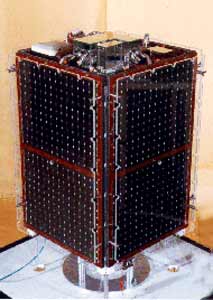Thank you very much for visiting Gunter's Space Page. I hope that this site is useful and informative for you.
If you appreciate the information provided on this site, please consider supporting my work by making a simple and secure donation via PayPal. Please help to run the website and keep everything free of charge. Thank you very much.
PoSAT 1 (POSAT-OSCAR 28, PO 28)

PoSAT 1 [SSTL]
PoSAT-1 (Portugese Satellite) is a collaborative research mission, combining tailor-made technology transfer, training, and a sophisticated ground and space segment microsatellite system.
The PoSAT-1 microsatellite has been built at the University of Surrey within a collaborative programme in satellite technology between a consortium of Portuguese academia and Industry (LNETI, EFACEC, OGMA, MARCONI, ALCATEL, IST, UBI & CEDINTEC) and the Univerity of Surrey, managed through Surrey Satellite Technology Ltd.
The PoSAT collaboration is similar in scope to SSTL's highly successful programme with South Korea, which led to the launch of KITSAT-1 in 1992. It has encompassed the installation by SSTL of a satellite groundstation near Lisbon, and the construction of an engineering model satellite by a national team in Portugal. Meanwhile, on-the-Job training and technology transfer to Portugal has been achieved by a team of seven Portuguese engineers working alongside SSTL engineers at Surrey on the design, construction and test of the first Portuguese satellite, PoSAT-1, for launch by Ariane in September 1993.
PoSAT-1 uses the SSTL modular microsatellite platform, previously proven on three research (UoSAT-3,4 and 5) and two commercial missions (S80/T and KITSAT-1). It carries a wide range of payloads:
- Earth Imaging System (EIS)
The PoSAT-1 EIS consists of two Charge-Coupled Device (CCD) imagers, two lenses and a Transputer Data Processing Experiment to provide on-board image processing and data compression. One imager has a wide field of view with 2 km ground resolution, the second narrow field imager provides 200 m ground resolution. - Star Sensor
The star sensor is based on the same technology as the EIS, but is optimised for imaging the faint light from stars for use as part of the spacecraft's attitude determination system. The star-field image is analysed by the Transputer Data Processing Experiment and the resulting measurement data returned on the On-Board-Computer. - GPS Navigation
PoSAT-1 carries a Global Positioning System (GPS) receiver based on the Trimble TANS-II receiver. The received data is decoded and filtered by the Transputer Data Processing Experiment to provide the satellite position and velocity as well as an accurate on-board time reference. This enables the satellite to generate its own orbital element set, provide scheduling and synchronisation to other on-board computers, and allow groundstations equipped with a GPS receiver to experiment with applications for real-time differential GPS data. - Cosmic Ray Experiment (CRE)
The CRE monitors the space radiation environment experienced in orbit by the satellite and enables analysis of its effect on spacecraft semiconductor electronics. The CRE contains a large area PIN diode and multi-channel analyser capable of detecting energetic particles with a wide range of Linear Energy Transfer to build up a spectrum of observed energies of particles within the spacecraft. Special RADFET's are also incorporated to monitor the accumulated ionising dose. The larger memory devices in the on-board computers are regularly 'washed' to detect and log Single Event Upset (SEU) information. - Digital Signal Processing Experiment (DSPE)
The DSPE consists of two Texas Instruments processors from the TMS320 series, the C25 and C30. The DSPE can be used as a programmable communications modem to modulate the downlink data from, or demodulate uplink data for the OBC, thus enabling experiments with new modulation techniques optimised for Low Earth Orbit satellite mobile communications. - Store and Forward communications
The main On-Board Computer (OBC), based on an 80C186 8 MHz processor with 16MByte of Static RAM, also supports digital Store and Forward communications using AX25 packet protocols and communications links optimised for communications using very low cost, simple and portable groundstations. The Store and Forward system employs a 9.6 kbps uplink and 9.6 and 38.4 kbps downlink data rates.
| Nation: | Portugal |
|---|---|
| Type / Application: | Earth observation, technology |
| Operator: | PoSAT consortium |
| Contractors: | SSTL |
| Equipment: | see above |
| Configuration: | Microsat-70 |
| Propulsion: | None |
| Power: | Solar cells, batteries |
| Lifetime: | |
| Mass: | |
| Orbit: | 822 km × 800 km, 98.6 |
| Satellite | COSPAR | Date | LS | Launch Vehicle | Remarks | |
|---|---|---|---|---|---|---|
| PoSAT 1 (POSAT-OSCAR 28, PO 28) | 1993-061G | 26.09.1993 | Ko ELA-2 | Ariane-40 H10 | with SPOT 3, Stella, Healthsat 2, Eyesat 1, Itamsat, Kitsat 2 |
References:
- SSTL: PoSAT-1
